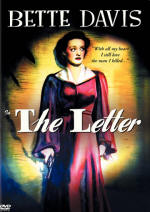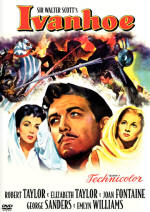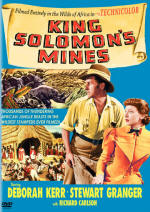Making movies. Enjoying movies. Remembering movies.
| Posted February 15, 2005 |
|
DVD Decision 2004
Second Wave Of Online Petition Titles Released |
By
Bill Desowitz
 |
 |
 |
 |
 |
The
five winners of DVD Decision 2004, the second online promotion from
Warner Home Video and Turner Classic Movies, in which movie fans cast
their votes for their most anticipated classics on DVD, are now
available: “The Letter” (1940), “Random Harvest" (1942), "King Solomon’s
Mines” (1950), “Ivanhoe" (1952), and "Ice Station Zebra” (1968).
It’s an eclectic, entertaining mix of romance, melodrama and adventure,
divided between Warner Bros. and MGM titles, and all five look
magnificent on disc. Not surprisingly, “The Letter” and “Random
Harvest” hold up for their subtle, intimate craftsmanship and emotional
resonance, while “King Solomon’s Mines” and “Ivanhoe” are absorbing in
their own right. Meanwhile, “Ice Station Zebra,” the Cold War
submarine thriller shot in Super Panavision 70, which Howard Hughes
called his favorite movie, is still a guilty pleasure despite its chilly
moments.
Director William Wyler seems particularly inspired by “The Letter,” an
early, exotic noir and reworking of the Somerset Maugham play that
reunited him with Bette Davis after “Jezebel.” Although it
contains one of the most powerful openings in movie history – a man
stumbles down the steps of a veranda, followed by Davis, who pumps
several gunshots into him and then coolly drops the gun – the ending is
just as stunning for its hypnotic mood and visual elegance, even though
it is marred by silly Production Code tampering.
Davis plays the bored wife of Herbert Marshall, the meek manager of a
rubber plantation in Malaya, who murders her secret lover when she
discovers that he is married to a Eurasian (Gale Sondergaard.
Davis tries to cover up her crime by claiming self-defense, but then is
forced to buy back an incriminating letter from the widow. Her
lawyer and family friend (brilliantly played by newcomer James
Stephenson, who tragically died of a heart attack a year later) becomes
the film’s moral compass, who is both attracted to and repelled by
Davis’ wicked charm. For her part, Davis is fascinating in her
unsympathetic role.
Apparently it was Wyler’s idea to cast Davis in moonlight to underscore
her suppressed guilt. He further enhanced the visual emblem by
using louvered blinds on the windows to print prison stripes on her like
a Scarlet Letter. Director and star bitterly fought over the final
confrontation between Davis and Marshall, in which he forgives her and
wants to start anew and she confesses: “I still love the man I killed.”
It seems that the star refused to look him in the eye and stormed off
the set. Wyler prevailed and the result is arguably Davis’ best
performance. Interestingly, the DVD contains an alternate ending
without the final confrontation between husband and wife. Needless
to say, it severely softens the blow. Too bad they didn’t shoot an
alternate ending to defy the Production Code.
Ronald Coleman, one of the few urbane actors to make the transition from
silents to talkies, nonetheless didn’t possess the warmest of personas,
yet was at his most charming and vulnerable in “Random Harvest,” one of
the best amnesia love stories ever made, directed with literate grace by
Mervyn LeRoy and produced by Sidney Franklin. But then, Greer
Garson often brought out the best in her male co-stars. Based on
the novel by James Hilton, where “Lost Horizon” meets “Goodbye, Mr.
Chips” in another ephemeral bliss, Coleman wanders out of an English
asylum in both a literal and figurative fog, just as the Armistice is
announced. He bumps into Garson, a music hall performer with
enough maternal love to nurse anyone back to health, and before you know
it, they’re married with a son in a sweet cottage in the country, when,
suddenly, they’re momentarily parted just as Coleman regains his
confidence, and an accident returns his memory and he’s back to his
dull, privileged, upper class life.
Then something truly bold happens when Garson slips anonymously back
into Coleman’s life in a subservient role just to be near him again.
Little by little, déjà vu kicks in, and she patiently and then
desperately tries to help him recapture their fleeting love. It’s
a delicate balancing act, of course, and the two stars pull it off
marvelously.
“King Solomon’s Mines” offers not only sprawling adventure but also the
dashing Stewart Granger as the famous hunter Allan Quartermain, lured
into deepest Africa by the flaming Deborah Kerr in search of her missing
husband and legendary treasure. Yet there is a melancholy tinge
that lies at the heart of Granger’s existential struggle, typified by
that wonderful moment when he shows Kerr miraculous life in the forest
by turning over a fallen tree, where thousands of bugs crawl underneath
a rotting limb. In Swahili, Granger says, “You eat me. I eat you.
We eat them. They eat us. Survival of the fittest.” In
some ways it’s more memorable than the incredible stampede that was shot
as an afterthought while they were on location. Speaking of which,
Robert Surtees’ Technicolor cinematography on location is gorgeous.
Speaking of somber, Sir Walter Scott’s “Ivanhoe” is a lot more serious
swashbuckler about the fight between the Normans and Saxons than the
younger and more popular “Robin Hood” legend. Here, Ivanhoe
(played by the handsome and stoic Robert Taylor) returns from the
Crusades to raise a ransom for King Richard the Lionhearted, held
captive in Austria. Disowned by his father (Finlay Currie), still
in love with Lady Rowena (Joan Fontaine, sister of Olivia DeHavilland,
oddly enough, from “The Adventures Of Robin Hood,” 1938), Ivanhoe
promises that King Richard will treat the Jews of England more humanely
if they help return him to the throne. He even appeals to Isaac of
York (Felix Aylmer) for financial assistance, whose daughter (Elizabeth
Taylor) quickly becomes smitten with him. This evil Prince John
(Guy Rolfe) is a lot more intense than Claude Rains, his counterpart in
“Robin Hood,” but, surprise, surprise, George Sanders steals the show as
the sensitive knight, Sir Brian de Bois-Guilbert. It’s a rousing
adventure, aided, among other things, by Freddie Young’s beautiful
Technicolor cinematography (shot on location in England), Alfred Junge’s
lavish art direction and Miklos Rozsa’s fiery score.
While neither as crafty as “The Guns Of Navarone” (1961) nor as pulpy as
“Where Eagles Dare” (1969, “Ice Station Zebra” nonetheless holds a
special, stoic place in the Alistair MacLean canon as a popcorn picture.
It takes itself way too seriously, though, perhaps because of its Cold
War relevance, yet director John Sturges just doesn’t have the kind of
inspiring material as he had with “Bad Day At Black Rock” (1955), “The
Great Escape” (1963), or “The Magnificent Seven” (1960). Still, as
submarine adventures go, this is quite a nail biter, as Rock Hudson
(terribly wasted) commandeers a nuclear sub to check out an abandoned
weather outpost at the North Pole, completely unaware of the global
peril that awaits them. It’s a pretty edgy group, ranging from
trigger happy Tony Bill, to hammy Ernest Borgnine, to implacable Jim
Brown. Thank goodness for the witty Patrick McGoohan as a cagey
British spy aboard to trap a Soviet spy. It’s corny fun, but for
some strange reason it holds its own against the much better “Hunt For
Red October” (1990). And it still strikes an emotional chord
—
punctuated by Michael Legrand's grand score. Go figure.
Bill Desowitz is a freelance writer and the editor of VFXWorld.com and a contributor to the Los Angeles Times, The New York Times, and Wired. He lives in Los Angeles.
Cover Images © Warner Home Video. All rights reserved
